One of the most untapped areas for shore fishing is the beautiful and dramatic coast line of Donegal in the northwest of Ireland.
I’ve been visiting Donegal for over 20-years, yet much of my fishing there has been from the boats, and that’s no surprise as the offshore fishing is absolutely superb. But on a recent visit I was more than keen to try and sneak in a little shore fishing.
Way back in 2000 I was fishing with Hugh John Patton, a Fisheries Inspector based in Ballyshannon, and he was telling me about the incredible shore fishing that some of the local lads enjoy. He mentioned a beach in the very far northwestern corner of Donegal Bay and it stuck in my mind ever since.
In 2000 Hugh John’s son, Michael Patton fished with us briefly. Michael is now a Fisheries Officer with the North West River Basin District of Inland Fisheries Ireland and I’d be teaming up with Mike, who’s not just an ultra keen angler, but also a successful boat match angler. That said, even Mike has not explored some of these more remote shore marks.
We’d work to do before we could go off exploring, but we chatted over possibilities and decided to try the beach, Silver Strand, that had stuck in my mind so long.
WHAT A PLACE!
The intention was to fish an evening session, daylight in to darkness over low water. The weather was not the best with heavy showers and a persistent strong wind from the west.
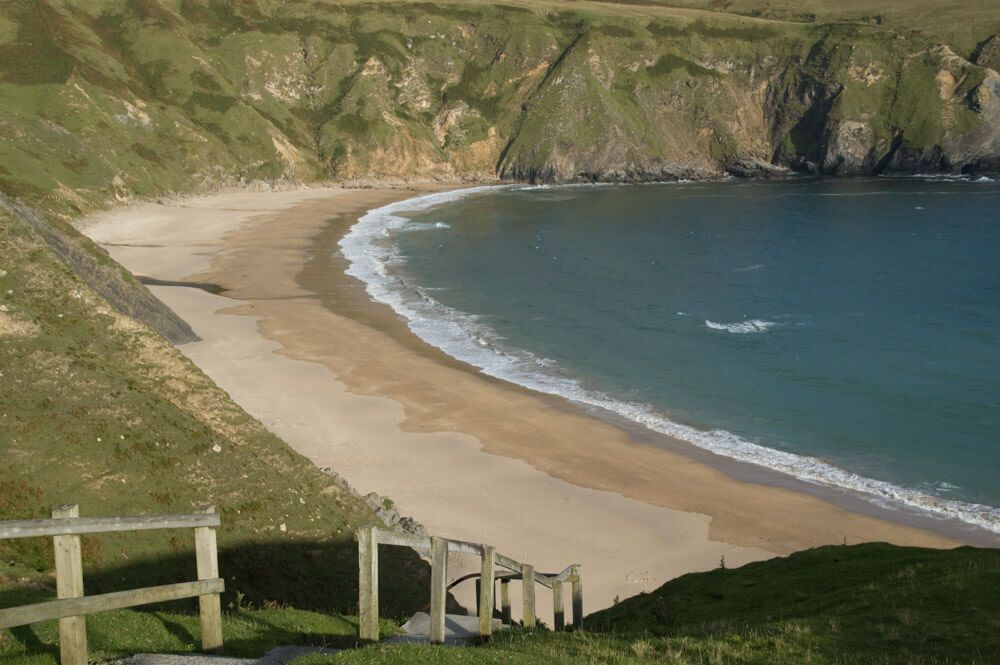
We parked above the beach and what a place it is! The beach is silvery sand and worthy of the name, steep in nature at the water line, flanked on both sides by long rocky headlands and virtually protected on all sides bar the south from the weather. As we looked down the surf was light and gentle, just enough to give life to the sea, with wind lines rippling across from the breeze that made it down in the cove. Outside the sea was white, angry and hinting of worse to come.
It’s a steep climb down concrete steps but we almost ran so eager where we to get baits in the water. We chose the west side to minimise any further rise in the wind and here it was virtually flat calm.
We set up with standard beachcasters and I chose a simple three-hook flapper on one for close range fishing, and a two-hook clipped up rig to be punched out further. I think Mike also used three-hook rigs.
We had fresh dug lug, squid, freshish mackerel and frozen sandeel for bait.
IT’S A FISH A CHUCK!
I dropped the three-hook rig out about 30-yards and put the rod in the rest. I walked round to the other side of the rest to pick up the other rod and saw the first rod tip rattle. This was a flounder about a pound. As I landed it I saw Mike strike in to a fish and beach another flounder about the same size.
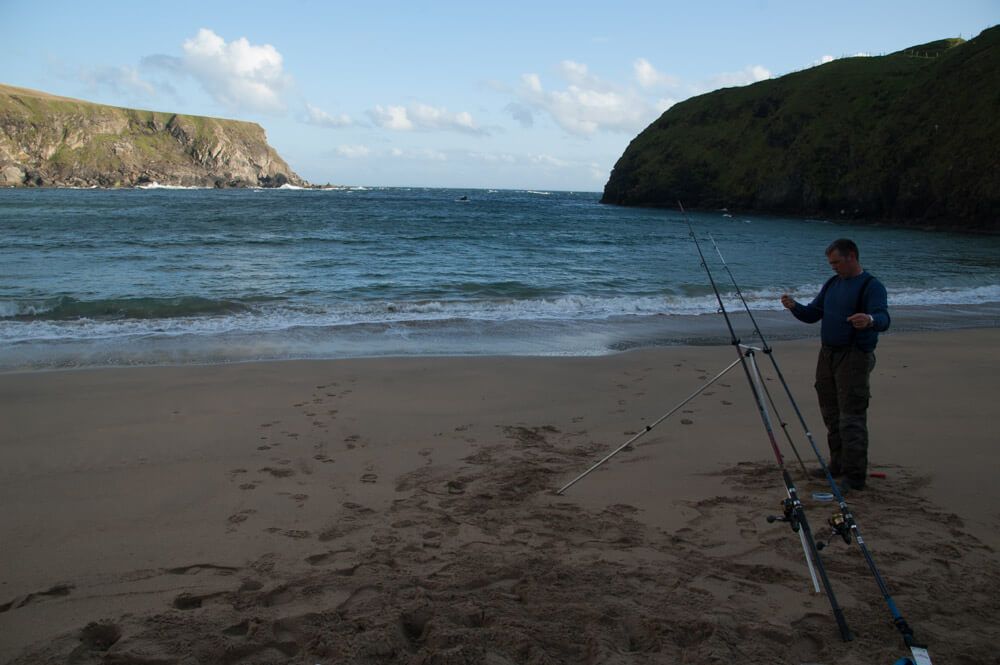
The second rod went out at range and this sat their calmly while I re baited the first rod and made a fresh cast. I was looking to double patt with a ready baited rig for each rod. This went out the window as the rod cast close immediately shuddered and the rod tip pulled over again. This was a double header of flounder. Mike shouted across and he was beaching a triple header of two flounder and a dogfish.
Because the beach is quite steep-to from the water line I’d been fishing to a tight line with the rod tip up at an angle from the water. I’d only caught on the bottom two hooks so far, so dropped the angle of the rod tip lower and left a couple of feet of slack line. My bite detection now would be by watching the bow in the line for lift bites. This simple change of tactic would ensure all three baits were on the seabed.
The sun had fallen behind the cliffs now and the light levels were dropping. Mike shouted across and he lifted up a flounder that looked 1½lbs on the bottom hook with a nice looking coalie on the middle hook. Coalies always come as the light goes.
I re-baited my long range rod which had shown no action at all. While doing so the short range one kicked a few times. On reeling in I’d got a triple header of flounder, the best looking to 1¾lbs and a thick set, solid bodied fish. My slack line tactic had paid off.
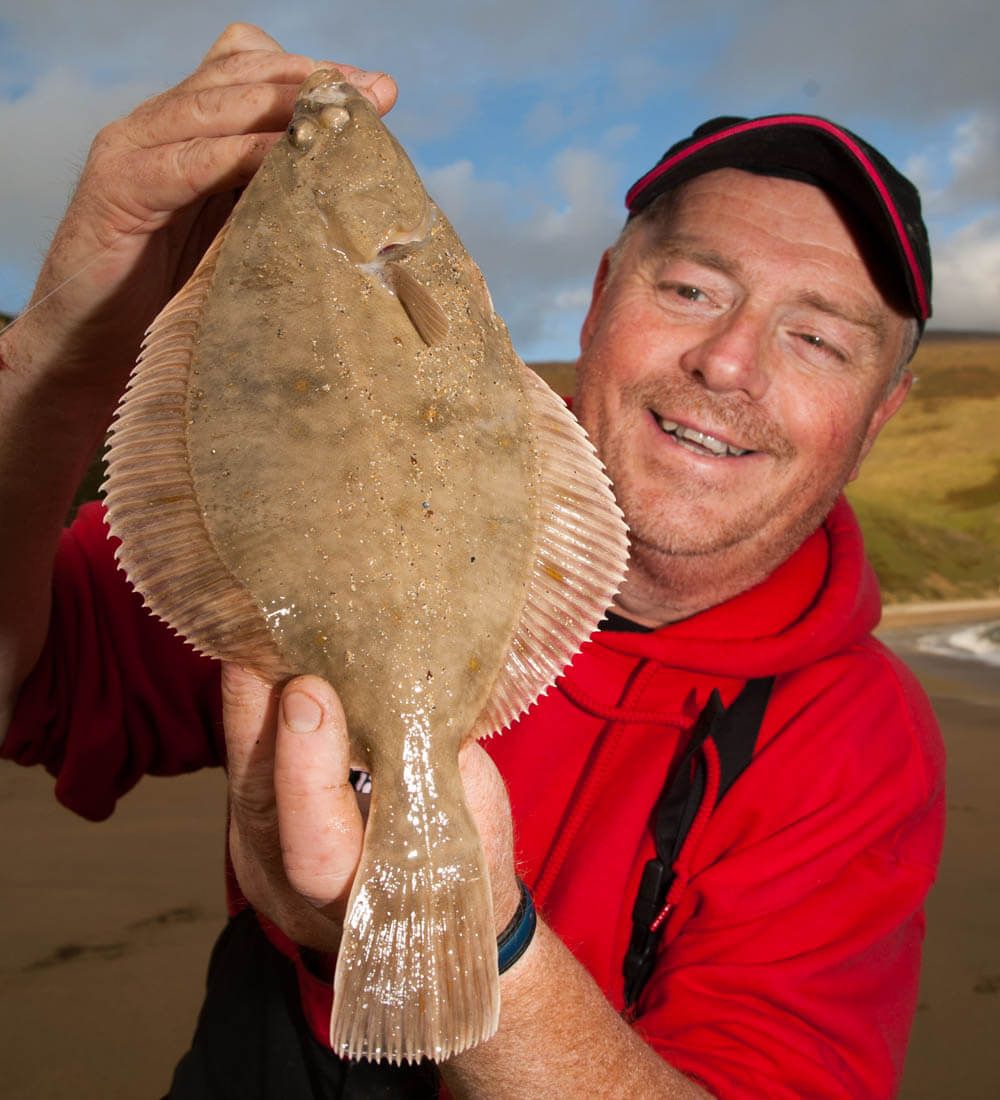
While all this was going on I’d also been sussing the best bait on the day. This turned out to be the mackerel, which was no real surprise. Swapping notes with Mike we’d both had fish on worm, but only a couple, the sandeel was not picking much up at all, and the squid had only caught a couple of dabs. Out went three mackerel baits to maximise catches.
Mike, being a competition angler, was preparing his baits with TLC and they looked a work of art. Me, well, I’d started creating nicely presented baits initially, but then the fish were so thick on the ground and feeding so quickly I just cut thin strips, put the hook through the flesh side and out through the skin and lobbed them out for speed. We were both catching at a rapid rate.
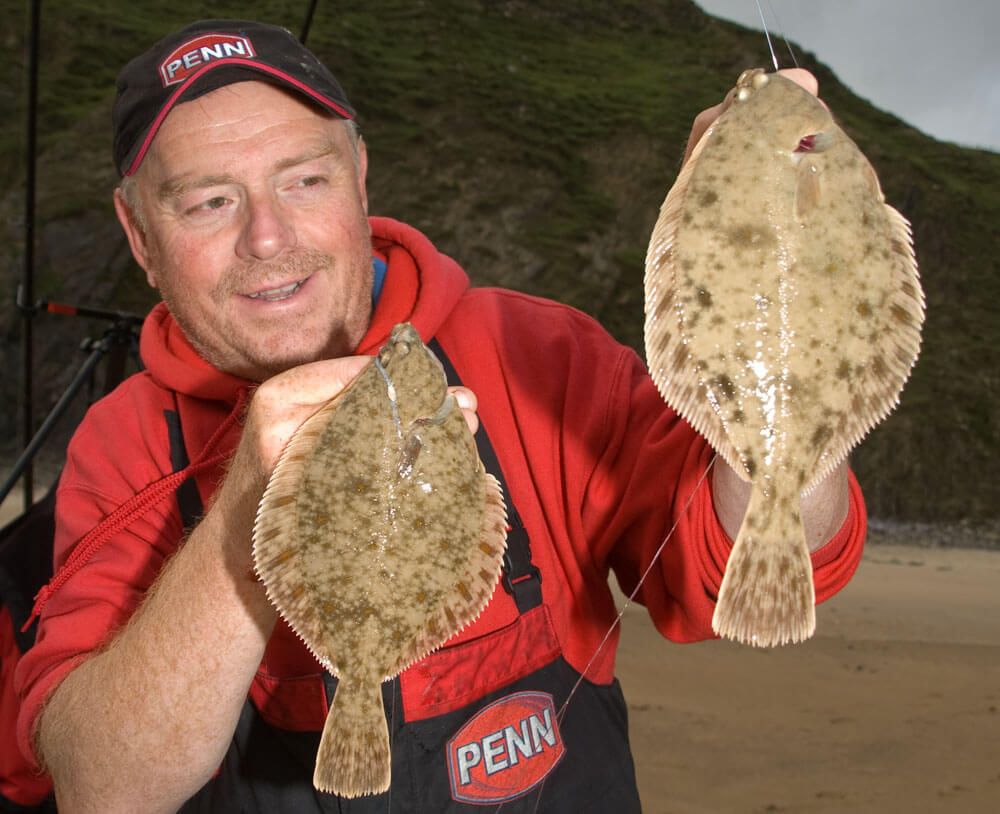
As dark came and the tide turned to flood I gave up on the long range rod and dropped that in at short range too! Now my work rate really picked up!
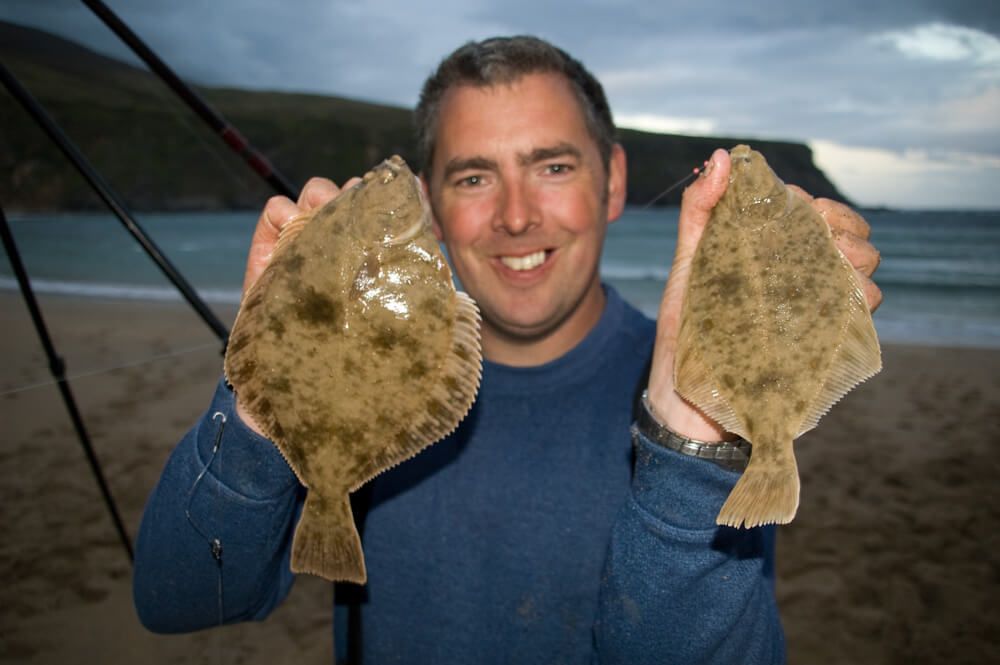
One rod was in at about 15-yards and the other twice that distance. The close rod was taking a succession of coalies and big flounder, then the turbot came on, though these were little fella’s up to about a half pound or so. The rod further out was hitting double and triple headers of flounder every chuck.
SPECIMEN FLOUNDER
Mike and I were like kids in a sweet shop. We kept glancing over at each other shouting, “Two flounder”, Triple header”, “Turbot, flounder and a coalie”, “Turbot, dab, flounder”, and so it went on. The fishing was that hectic I was sweating so much it was dripping off my nose!
In to full dark now and the fishing got even better. Some of the flounder were absolute crackers and Mike shouted to bring the camera over. When I got there he’d got a stunning looking fish that, to me, was close to or over 2lbs and a potential Irish specimen. Like idiots we’d left the scales at home to reduce weight due to the cliff climb. We briefly thought about retaining the fish for weighing, but both looked at each other and without saying a word Mike went to the waters edge, held the fish in the surf, and it kicked off back to sea.
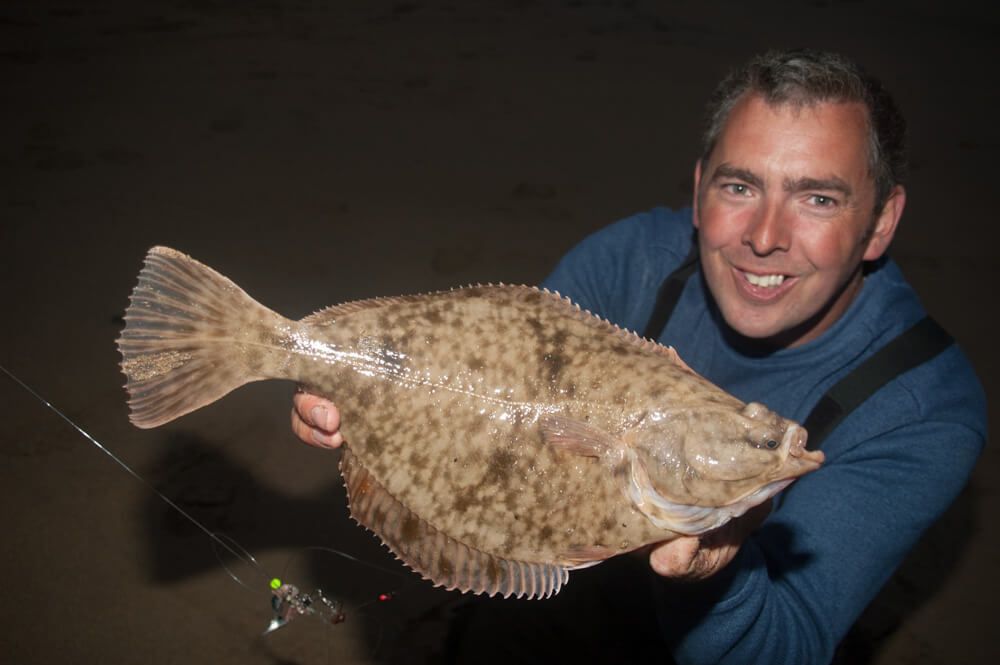
We had another manic hour of just hauling fish in singles, doubles and triples. It was incredible fishing. We were running out of bait and just recycled old baits to make a good one, and still caught at the same speed.
Mike, being younger and more precise than me nowadays, had been keeping a rough count of the fish caught, or trying to. He reckoned in a tad over four hours fishing we’d had well in excess of 60 fish and with hindsight talking on the way home we think that an extremely conservative estimate . It felt like it was as my back, legs and arms were aching from the sheer physical effort of continually casting, retrieving, unhooking fish, re baiting and casting again.
CONCLUSION
What impressed me most was the quality of the flounder, most were pound plus fish with many over 1½lbs. For numbers I’ve only witnessed similar fishing a couple of times before in my lifetime and both those trips were in Ireland too.
Looking objectively at the session fishing two hours either side of low water, I think the next time I fish here I’d look to fish the full flood up and would leave that long range rod out there. I think this would produce spotted, small blonde and maybe thornback ray, but definitely better turbot. I think these fish wait in the deeper water only moving in in the mid tide period when the tide picks up inside the bay.
I’d also swap one rod for a bass rod or light spinning rod to maximise the fun with the flounders, coalies, turbot and dabs.
This mark will undoubtedly produce good plaice during daylight, especially from the east side where the sun hits the water for the longest part of the day.
I’d also like to get back here for a week in winter and really suss this beach. It looks a dead cert for good coalies, cod, big whiting, and also the flounder fishing may be even better. Certainly the biggest flounder and dabs will show from November on.
You know what? This area is not noted for bass fishing, but I feel an angler consistently fishing this beach from August through to Christmas might just get a shock one night and land a real belter. I’d put money on a southerly wind and decent surf pushing through the bay to produce a good fish that comes in to the surf to feed on the little flatties. Whole squid, a big lug bait, or a section of bluey would be the killer bait!
This is just one mark of hundreds that only rarely if ever sees an angler fish it in this region. The potential throughout the summer is awesome, but also, as I mentioned, the winter fishing would be equal to it. The weather is almost immaterial as you have so many marks you can find shelter on and they’ll all fish well to the right tactics.
Anyone fancying a weeks fishing, winter or summer, then I’d recommend basing yourself in the Ballyshannon/Killybegs area and fish until you drop!
ACCOMODATION
I stayed at Pat’s B&B, East End, Bundoran, Co Donegal, Ireland. Tel: 00 353 71 9842148 . The house offers great rooms, is angler friendly, has safe private parking and you get a cracking breakfast! The pubs and takeaway’s are just a few yards away too!
There are also numerous other B&B houses, guesthouse accommodation and camp sites available locally.
ANGLING INFORMATION
Silver Strand, and the whole of the northern end of Donegal Bay, falls within the North West River Basin District for Inland Fisheries Ireland, Station Road, Ballyshannon, Donegal, Ireland. Tel: 00 353 71 9851435. E-mail enquiries: info@nrfb.ie
Further angling information including additional contact numbers, marks, maps, fishing reports and tackle shop information can be found on the excellent Inland Fisheries Ireland website www.fisheriesireland.ie
TOURIST & ANGLING INFORMATION
For accommodation, holiday and angling information phone Tourism Ireland 0800 294 2009, or visit www.discoverireland.com/angling .
ADMIRALTY CHART
Admiralty Chart no 2702 covers the whole of Donegal Bay.
TRAVEL
Most anglers choose to travel by ferry via Holyhead to Dublin Port, it’s then an easy 3-hour drive or so nowadays to Ballyshannon and Killybegs. Take the north toll road from the port which avoids the Dublin traffic. For more information contact Stena Line Tel: 08705 707070 or access www.stenaline.co.uk.
I’ve been visiting Donegal for over 20-years, yet much of my fishing there has been from the boats, and that’s no surprise as the offshore fishing is absolutely superb. But on a recent visit I was more than keen to try and sneak in a little shore fishing.
Way back in 2000 I was fishing with Hugh John Patton, a Fisheries Inspector based in Ballyshannon, and he was telling me about the incredible shore fishing that some of the local lads enjoy. He mentioned a beach in the very far northwestern corner of Donegal Bay and it stuck in my mind ever since.
In 2000 Hugh John’s son, Michael Patton fished with us briefly. Michael is now a Fisheries Officer with the North West River Basin District of Inland Fisheries Ireland and I’d be teaming up with Mike, who’s not just an ultra keen angler, but also a successful boat match angler. That said, even Mike has not explored some of these more remote shore marks.
We’d work to do before we could go off exploring, but we chatted over possibilities and decided to try the beach, Silver Strand, that had stuck in my mind so long.
WHAT A PLACE!
The intention was to fish an evening session, daylight in to darkness over low water. The weather was not the best with heavy showers and a persistent strong wind from the west.

We parked above the beach and what a place it is! The beach is silvery sand and worthy of the name, steep in nature at the water line, flanked on both sides by long rocky headlands and virtually protected on all sides bar the south from the weather. As we looked down the surf was light and gentle, just enough to give life to the sea, with wind lines rippling across from the breeze that made it down in the cove. Outside the sea was white, angry and hinting of worse to come.
It’s a steep climb down concrete steps but we almost ran so eager where we to get baits in the water. We chose the west side to minimise any further rise in the wind and here it was virtually flat calm.
We set up with standard beachcasters and I chose a simple three-hook flapper on one for close range fishing, and a two-hook clipped up rig to be punched out further. I think Mike also used three-hook rigs.
We had fresh dug lug, squid, freshish mackerel and frozen sandeel for bait.
IT’S A FISH A CHUCK!
I dropped the three-hook rig out about 30-yards and put the rod in the rest. I walked round to the other side of the rest to pick up the other rod and saw the first rod tip rattle. This was a flounder about a pound. As I landed it I saw Mike strike in to a fish and beach another flounder about the same size.

The second rod went out at range and this sat their calmly while I re baited the first rod and made a fresh cast. I was looking to double patt with a ready baited rig for each rod. This went out the window as the rod cast close immediately shuddered and the rod tip pulled over again. This was a double header of flounder. Mike shouted across and he was beaching a triple header of two flounder and a dogfish.
Because the beach is quite steep-to from the water line I’d been fishing to a tight line with the rod tip up at an angle from the water. I’d only caught on the bottom two hooks so far, so dropped the angle of the rod tip lower and left a couple of feet of slack line. My bite detection now would be by watching the bow in the line for lift bites. This simple change of tactic would ensure all three baits were on the seabed.
The sun had fallen behind the cliffs now and the light levels were dropping. Mike shouted across and he lifted up a flounder that looked 1½lbs on the bottom hook with a nice looking coalie on the middle hook. Coalies always come as the light goes.
I re-baited my long range rod which had shown no action at all. While doing so the short range one kicked a few times. On reeling in I’d got a triple header of flounder, the best looking to 1¾lbs and a thick set, solid bodied fish. My slack line tactic had paid off.

While all this was going on I’d also been sussing the best bait on the day. This turned out to be the mackerel, which was no real surprise. Swapping notes with Mike we’d both had fish on worm, but only a couple, the sandeel was not picking much up at all, and the squid had only caught a couple of dabs. Out went three mackerel baits to maximise catches.
Mike, being a competition angler, was preparing his baits with TLC and they looked a work of art. Me, well, I’d started creating nicely presented baits initially, but then the fish were so thick on the ground and feeding so quickly I just cut thin strips, put the hook through the flesh side and out through the skin and lobbed them out for speed. We were both catching at a rapid rate.

As dark came and the tide turned to flood I gave up on the long range rod and dropped that in at short range too! Now my work rate really picked up!

One rod was in at about 15-yards and the other twice that distance. The close rod was taking a succession of coalies and big flounder, then the turbot came on, though these were little fella’s up to about a half pound or so. The rod further out was hitting double and triple headers of flounder every chuck.
SPECIMEN FLOUNDER
Mike and I were like kids in a sweet shop. We kept glancing over at each other shouting, “Two flounder”, Triple header”, “Turbot, flounder and a coalie”, “Turbot, dab, flounder”, and so it went on. The fishing was that hectic I was sweating so much it was dripping off my nose!
In to full dark now and the fishing got even better. Some of the flounder were absolute crackers and Mike shouted to bring the camera over. When I got there he’d got a stunning looking fish that, to me, was close to or over 2lbs and a potential Irish specimen. Like idiots we’d left the scales at home to reduce weight due to the cliff climb. We briefly thought about retaining the fish for weighing, but both looked at each other and without saying a word Mike went to the waters edge, held the fish in the surf, and it kicked off back to sea.

We had another manic hour of just hauling fish in singles, doubles and triples. It was incredible fishing. We were running out of bait and just recycled old baits to make a good one, and still caught at the same speed.
Mike, being younger and more precise than me nowadays, had been keeping a rough count of the fish caught, or trying to. He reckoned in a tad over four hours fishing we’d had well in excess of 60 fish and with hindsight talking on the way home we think that an extremely conservative estimate . It felt like it was as my back, legs and arms were aching from the sheer physical effort of continually casting, retrieving, unhooking fish, re baiting and casting again.
CONCLUSION
What impressed me most was the quality of the flounder, most were pound plus fish with many over 1½lbs. For numbers I’ve only witnessed similar fishing a couple of times before in my lifetime and both those trips were in Ireland too.
Looking objectively at the session fishing two hours either side of low water, I think the next time I fish here I’d look to fish the full flood up and would leave that long range rod out there. I think this would produce spotted, small blonde and maybe thornback ray, but definitely better turbot. I think these fish wait in the deeper water only moving in in the mid tide period when the tide picks up inside the bay.
I’d also swap one rod for a bass rod or light spinning rod to maximise the fun with the flounders, coalies, turbot and dabs.
This mark will undoubtedly produce good plaice during daylight, especially from the east side where the sun hits the water for the longest part of the day.
I’d also like to get back here for a week in winter and really suss this beach. It looks a dead cert for good coalies, cod, big whiting, and also the flounder fishing may be even better. Certainly the biggest flounder and dabs will show from November on.
You know what? This area is not noted for bass fishing, but I feel an angler consistently fishing this beach from August through to Christmas might just get a shock one night and land a real belter. I’d put money on a southerly wind and decent surf pushing through the bay to produce a good fish that comes in to the surf to feed on the little flatties. Whole squid, a big lug bait, or a section of bluey would be the killer bait!
This is just one mark of hundreds that only rarely if ever sees an angler fish it in this region. The potential throughout the summer is awesome, but also, as I mentioned, the winter fishing would be equal to it. The weather is almost immaterial as you have so many marks you can find shelter on and they’ll all fish well to the right tactics.
Anyone fancying a weeks fishing, winter or summer, then I’d recommend basing yourself in the Ballyshannon/Killybegs area and fish until you drop!
ACCOMODATION
I stayed at Pat’s B&B, East End, Bundoran, Co Donegal, Ireland. Tel: 00 353 71 9842148 . The house offers great rooms, is angler friendly, has safe private parking and you get a cracking breakfast! The pubs and takeaway’s are just a few yards away too!
There are also numerous other B&B houses, guesthouse accommodation and camp sites available locally.
ANGLING INFORMATION
Silver Strand, and the whole of the northern end of Donegal Bay, falls within the North West River Basin District for Inland Fisheries Ireland, Station Road, Ballyshannon, Donegal, Ireland. Tel: 00 353 71 9851435. E-mail enquiries: info@nrfb.ie
Further angling information including additional contact numbers, marks, maps, fishing reports and tackle shop information can be found on the excellent Inland Fisheries Ireland website www.fisheriesireland.ie
TOURIST & ANGLING INFORMATION
For accommodation, holiday and angling information phone Tourism Ireland 0800 294 2009, or visit www.discoverireland.com/angling .
ADMIRALTY CHART
Admiralty Chart no 2702 covers the whole of Donegal Bay.
TRAVEL
Most anglers choose to travel by ferry via Holyhead to Dublin Port, it’s then an easy 3-hour drive or so nowadays to Ballyshannon and Killybegs. Take the north toll road from the port which avoids the Dublin traffic. For more information contact Stena Line Tel: 08705 707070 or access www.stenaline.co.uk.

